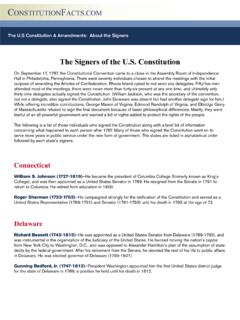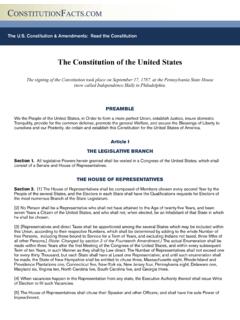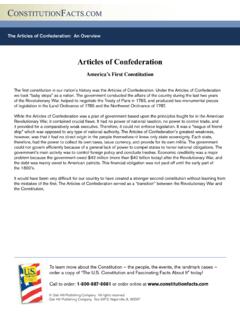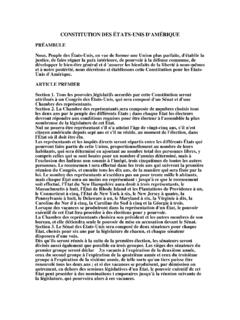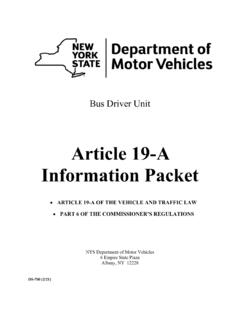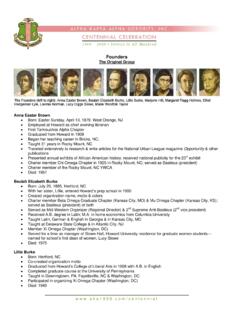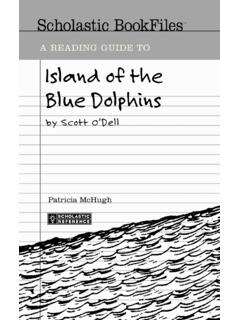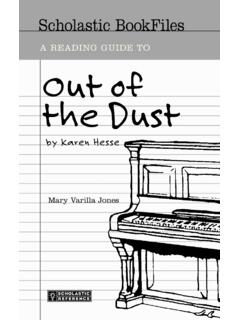Transcription of Twenty-Five Landmark Cases in Supreme Court History
1 The Supreme Court : Landmark Cases (Continued) Twenty-Five Landmark Cases in Supreme Court HistoryMarbury v. Madison, 1803 A law repugnant to the Constitution is void. With these words, Chief Justice John Marshall established the Supreme Court s role in the new government. Hereafter, the Court was recognized as having the power to review all acts of Congress where constitutionality was at issue, and judge whether they abide by the v. Maryland, 1819 Let the end be legitimate .. and all means which are .. consistent with the letter and spirit of the Constitution, are constitutional . Chief Justice Marshall invoked this phrase to establish the right of Congress to pass laws that are necessary and proper to conduct the business of the government.
2 Here, the Court upheld Congress power to create a national v. Ogden, 1824 When a federal and state law are in conflict, the federal law is and new york had both passed laws regulating the steamboat industry. Gibbons had a federal permit for a steamboat business; Ogden had a state permit for the same waters. Siding with Gibbons, the Court said that, in matters of interstate commerce, the Supremacy Clause tilts the balance of power in favor of federal River Bridge, 1837 The responsibility of government is to sacredly guard the rights of property for the prosperity of the Charles River Bridge was erected in 1785 by Harvard College and some prominent Bostonians under a legal charter granted by the state of Massachusetts.
3 The legislature granted a charter to the Warren Bridge Company in 1828 because a new bridge was badly needed. It was to be free of tolls once construction costs were covered. The proprietors of the Charles River Bridge were afraid that the new bridge would destroy the value of their stock and tried to block the construction of the Warren Bridge. The case involved a conflict between established rights on one side and the rights of the community on the other. The Court ruled that it had not entered into a binding contract with the Charles River Bridge Company that would prohibit the building of a competitive bridge. Justice Roger B. Taney stated that the rights of property must be sacredly guarded , the community also has rights, and the responsibility of all government is to promote the happiness and prosperity of the Supreme Court : Landmark Cases (Continued)Dred Scott v.
4 Sandford, 1857 The Constitution does not consider slaves to be citizens. Rather, they are constitutionally protected property of their masters. Chief Justice Roger Taney authored this opinion one of the most important and scorned in the nation s History . Dred Scott, a slave, had moved with his master to Illinois, a free state. He moved again to a slave state, Missouri, and filed suit to gain freedom, under that state s law of Once free, always free. Taney held that Scott had never been free at all, and cited Constitutional grounds for placing the slavery decision in the hands of the states. In trying to put an end to the slavery controversy, Taney instead sped the nation toward civil war.
5 The decision was later overturned by the Thirteenth v. Illinois, 1877 Businesses that serve the public interest are subject to regulation by state Illinois state legislature passed a law that established the maximum rates that private companies could charge in storing or transporting agricultural products. In Chicago the company of Munn and Scott was found guilty of breaking the law and the verdict was upheld on appeal before the Supreme Court . The appeal was heard along with seven other railroad Cases that dealt with the violation of the regulatory legislation passed by the state of Illinois. The Court ruled that any business that served the public interest was subject to regulation by the state government.
6 If the rates were not satisfactory according to the owners of the companies, the complaints should be taken to the legislature and not to the v. Ferguson, 1896 Jim Crow laws are constitutional under the doctrine of Separate but Equal. Police arrested Homer Plessy for refusing to leave a railroad car that prohibited colored people. Under Louisiana law, Plessy was colored because he was one-eighth black. The Court ruled that the race-based Jim Crow laws did not violate the Constitution as long as the states proffered separate but equal treatment. The Constitution is color blind, and neither knows nor tolerates classes among citizens.
7 Justice John Marshall Harlan, from the lone dissenting opinion in Plessy v. FergusonLochner v. new york , 1905 The Constitution bars a state from interfering with an employee s right to contract with an above reasoning led to the Lochner Era thirty-two years of wrangling between the Court and legislatures. Lochner s bakery violated a new york labor law. The Court struck down the law, saying that the 14th Amendment s Due Process Clause barred states from regulating commerce in this manner. This clause, the Court said, implied that individuals have a fundamental right to contract with employers, and states cannot interfere with that Supreme Court : Landmark Cases (Continued)Schenck v.
8 United States, 1919 Speech that presents a clear and present danger to the security of the United States is in violation of the principle of free speech as protected by the First Amendment to the World War I (1918), Charles Schenck was the general secretary of the Socialist Party, and was arrested for distributing literature discouraging young men from enlisting in the armed forces. The basis for his opposition to the draft or enlistment was the first clause of the Thirteenth Amendment which prohibited slavery or involuntary servitude. Schenck appealed his conviction and the case went to the Supreme Court . Justice Oliver Wendell Holmes stated that the character of every act depends upon the circumstances in which it is done.
9 The most stringent protection of free speech would not protect a man in falsely shouting fire in a theatre and causing a panic. [The] question in every case is whether the words used are used in such circumstances and are of such a nature as to create a clear and present danger that they will bring about the substantive evils that Congress has a right to prevent. Distributing the literature during peace time would have been an entirely different matter, but in time of war Schenck s actions, according to the Court , presented a clear and present danger to the security of the United v. Minnesota, 1931 The liberty of the press .. is safeguarded from invasion by state action.
10 Although the First Amendment ensures a free press, until this case, it only protected the press from federal laws, not state laws. Minnesota shut down J. M. Near s Saturday Press for publishing vicious antisemitic and racist remarks. In what is regarded as the Landmark free press decision, the Court ruled that a state cannot engage in prior restraint ; that is, with rare exceptions, it cannot stop a person from publishing or expressing a Coast Hotel v. Parrish, 1937 The switch in time that saved nine. F. D. R. rallied against the Court s holdings in the Lochner era. The Court struck down New Deal laws, designed to pull the country out of the Depression, on grounds that they interfered with a worker s right to contract.
